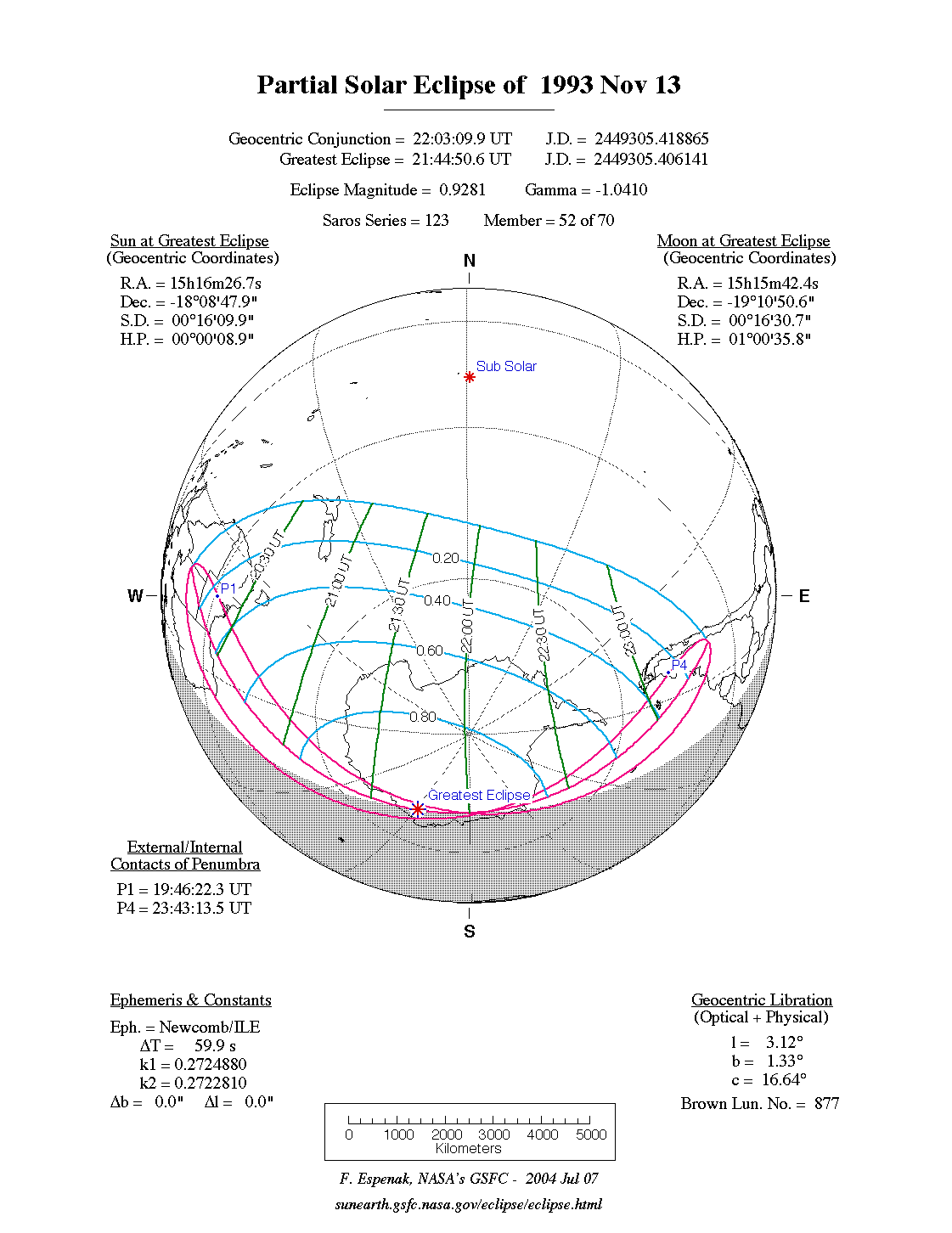A partial eclipse of the Sun occurred on Saturday 13 November, 1993 UT, with maximum eclipse at 21:44 UT. This was a deep partial eclipse, with 93% of the Sun covered for viewers closest to the center. This provided a significant spectacle for those who saw it.
Maximum eclipse was at 21:44:51 UT.
During this eclipse the Sun was 0.539° in apparent
diameter, 1.1% larger than average. The Moon was just a day past perigee, making it fairly large.
At maximum eclipse it was 0.550° in apparent
diameter, which is 3.6% larger than average. This has no real
effect on this eclipse, since the Moon's central
shadow misses the Earth, making this a partial eclipse.
The statistics page has information on the ranges of the sizes of
the Sun and Moon, and the Moon data page displays detailed
information on the Moon's key dates.
Overview Map
This map sourced from NASA Goddard Space flight Center: GSFC Eclipse Web SiteGSFC Eclipse Web Site
The primary source of all the information on eclipses presented here at Hermit Eclipse. (NASA Goddard Space flight Center)
shows the visibility of the partial solar eclipse. (Click on it for the
full-sized version.)
Eclipse Season and Saros Series
This eclipse season contains 2 eclipses:
This was the 52nd eclipse in solar Saros series 123.The surrounding eclipses in this Saros series are:
This Saros series, solar Saros series 123,
is linked to lunar Saros series 116. The
nearest partner eclipses in that series are:
Eclipse Parameters
| UT Date/time (max) | 21:44:51 on 13 Nov UT |
TDT Date/time (max) | 21:45:51 on 13 Nov TDT |
| Saros Series | 123 |
Number in Series | 52 |
| Penumbral Magnitiude | |
Central Magnitiude | 0.928 |
| Gamma | -1.0411 |
Path Width (km) | 0 |
| Delta T | 1m00s |
Error | ± 0m00s (95%) |
| Penumbral Duration | |
Partial Duration | |
| Total Duration | |
| |
| Partial Rating | |
Total Rating | |
| Sun Distance | 148012727 km (19.0%) |
Moon Distance | 361859 km (10.9%) |
| Sun Diameter | 0.539° |
Moon Diameter | 0.550° - 0.550° |
| Perigee | 12:06 on 12 Nov UT |
Apogee | 12:33 on 24 Nov UT |
Note that while all dates and times on this site (except
where noted) are in UT, which is within a second of civil time,
the dates and times shown in NASA's eclipse listingsGSFC Eclipse Web Site
The primary source of all the information on eclipses presented here at Hermit Eclipse. (NASA Goddard Space flight Center)
are in the TDT timescale.
The Sun and Moon distances are shown in km, and as a
percentage of their minimum - maximum distances; hence 0%
is the closest possible (Earth's perihelion, or the
Moon's closest possible perigee) and 100% is
the farthest (aphelion, the farthest apogee).
The statistics page has information on the ranges of sizes
of the Sun and Moon, and the Moon data page displays detailed
information on the Moon's key dates.
Data last updated: 2015-06-21 22:11:46 UTC.

